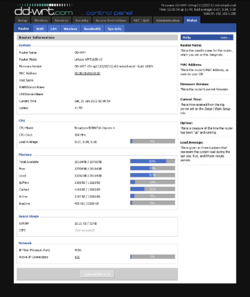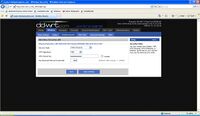TechInfoDepot:DD-WRT
 | |
 DD-WRT's Web Interface | |
| Developer(s) | Sebastian Gottschall / NewMedia-NET |
|---|---|
| Repository | [{{#property:P1324}} {{#property:P1324}}] |
| Type | Router operating system |
| License | GNU General Public License Template:Cn |
| Website |
dd-wrt.com Wiki Forum V24 Simulator |
It is extremely important to follow the guidelines for your specific device. Please see Installation for more information. Remember to follow the Peacock Thread first for background, use this page to identify your device model correctly, and use the dd-wrt download search page (DD-WRT Downloads page or secure version) to ensure that you are getting the correct file (or files, as often is required) for the job.
Introduction
DD-WRT is a third party developed firmware released under the terms of the GPL for many ieee 802.11a/b/g/h/n wireless routers based on a Broadcom or Atheros chip reference design.
The firmware is maintained by BrainSlayer and is hosted at dd-wrt.com. The first versions of DD-WRT were based on the Alchemy Firmware from Sveasoft Inc, which is in turn based on the original GPL'd Linksys firmware and a number of other open source projects. DD-WRT was created directly from Sveasoft's software decision to start charging for their firmware, closing the door to opensource.
At present DD-WRT is available for free, although a different business model is being drafted by BrainSlayer in order to pay his salary, as this is his full time job.
The new version of DD-WRT (v24) is a completely new project. DD-WRT offers many advanced features not found in the OEM firmwares of these devices, or even the firmware available for purchase from Sveasoft. It is also free of the product activation or tracking found in the Sveasoft firmware.
Note: Beta firmware, by its very nature, will contain bugs. It is not recommended to install beta firmware on large networks that are used for businesses, etc. However, there is now a bugtracker in place for DD-WRT firmware located here: DD-WRT Bugtracker.
Among other features not found in the original Linksys firmware, DD-WRT adds the Kai Daemon for the Kai Console Gaming network, WDS wireless bridging/repeating protocol, Radius Authentication for more secure wireless communication, advanced Quality of Service controls for bandwidth allocation, and software support for the SD-Card hardware modification.
What does dd stand for in dd-wrt? Sash: its the German car numberplate code for Dresden.
Installation
Requirements
- A computer(PC/MAC/ECT...)
- A broadband internet connection (Cable, or similar)
- A Linksys WRT54G/GL/GS router or other supported router.
- The DD-WRT firmware image from The DD-WRT Project
- Follow the instructions under Installation to install the new firmware on your router.
- FOLLOW RULES**
Which V24 build do I flash onto my router
DD-WRT Tutorials
Looking for La Fonera tutorials? La Fonera has it's own section over here --> LaFonera
Basic Tutorials
These tutorials have content most new users will understand and be able to deploy.
Advanced Tutorials
These tutorials require a certain degree of knowledge about general networking that some new users may or may not understand.
Scripting
|
|
Installable packages
This list covers additional software that can be installed on devices running DD-WRT. Note that you can install any OpenWRT package, using ipkg. Additionally more than 1000 packages are provided with NSLU2-Linux Optware packages build specially for DD-WRT.
|
|
Links to Good information not in the tutorials yet
- USB Hotplug Script Support
- Mobile Broadband Supported Device
- GUIDE: DHCP Dual-WAN with Failover for Linksys WRT310N v2
- (Tutorial) Building ShairPort from scratch!
- How to Tune Swap Setting on Linux for Maximum Performance
- Guide to Mediatomb (UPnP Media Server) with K26-only Routers
- To turn cisco led blue / white ...
- Project:DD-WRT/Bandwidth Usage Monitor
- Guide to Mediatomb (UPnP Media Server) with K26-only Routers
- Dual WAN Guide
- Would like ability to turn off "Cross Site Action detected" error
- help needed - 3 xbox 360's needing open nat
- http://www.networktutorials.info
- More than 1 web server behind DD-WRT
- Can't get nocat? Here's an alternative.
- White List
- X86
- Glossary
- Everything you Ever Wanted to know about Serial - TTL
- The Networking 101 for Dummies pre-wiki Thread
- Everything you Ever Wanted to know about XBox connections
- IPv6 updated instructions and scripts for v24
- Wireless-N Throughput Testing
- WHR-G300N - Access Point & Repeater Bridge - HOW-TO
- Client Bridge, AKA Repeater Bridge on WRT-160NL
- howto: REPEATER MODE in Atheros
- dropbear SFTP Access
Broadcom Specific
- Advantages of NEWD-2 over NEWD
- Routers that will and won't support K2.4 NEWD-2 - dd-wrt wiki
- Routers that will and won't support K2.4 NEWD-2
- Routers that will and won't support K2.6 NEWD-2
- Routers that will and won't support VLAN
Links of Interest
- Compiling DD-WRT
- full IPv6 support in DD-WRT if you're willing to do a little work
- Multiple Gateways one subnet
Issues
Fix for new broadcom Wireless Driver
You can set it manually for now:
nvram set wl0_nbw_cap=1 nvram set wl1_nbw_cap=1 nvram commit reboot
802.11 over 2.4GHz and 5GHz
Per GeeTek:
From my understanding and experiential discoveries, 802.11B, 802.11G and 802.11N are strictly modulation protocols. These protocols could be used in any frequency band.
802.11A is not a modulation specification, but instead a specific reference to the 5 GHz RF band. Ubiquity for sure has ( and other manufactures may have ) 802.11G and 802.11N modulated devices that operate in both the 5 GHz and 2.4 GHz band. If that all sound confusing then rest assured I am just as confused as to why the same specification format represents two different things ( modulation scheme versus frequency band ID )
To my knowledge no vendor or hardware manufacturer has ever produced 802.11B modulated hardware in the 5 GHz band, although in theory it would certainly function. Ubiquity firmware has recently added 802.11B support, and since this same firmware runs on both the 2.4 GHz and 5 GHz hardware I could safely guess that Ubiquity would support an 802.11b device on 5 GHz if one ever came along.
Now that the theory is out of the way, this new brand of radio is indeed extremely interesting. They appear to be a Ubiquity clone/knock-off. Enough so that I am going to purchase some of their gear and test it against Ubiquity hardware. I already see from the documentation that they have evolved some better functionality over their Ubiquity parent.
Loopback Broken
Trac Ticket - Ticket #1868
Users wanting to fix it themselves need to add iptables rules to their firewall script on the admin->commands page. For a standard configuration only this command is needed.
iptables -t nat -I POSTROUTING -o br0 -s 192.168.1.0/24 -d 192.168.1.0/24 -j MASQUERADE
If you use a different subnet for your LAN then you will need to change the subnet in the command to match yours or use this set of commands.
LAN=`nvram get lan_ipaddr`/`nvram get lan_netmask` iptables -t nat -I POSTROUTING -o br0 -s $LAN -d $LAN -j MASQUERADE
If you have a more advanced configuration with additional interfaces on the LAN side such as unbridged wireless, unbridged VPN, additional VLAN's, etc. then you will need to create commands similar to the first one for each of your local interfaces that you want to enable loopback for.
This set of commands should enable loopback for all local interfaces.
insmod ipt_mark insmod xt_mark iptables -t mangle -A PREROUTING -i ! `get_wanface` -d `nvram get wan_ipaddr` -j MARK --set-mark 0xd001 iptables -t nat -A POSTROUTING -m mark --mark 0xd001 -j MASQUERADE
k2.6 builds no longer support old devices
| WARNING: Current K2.6 builds after ~16500 no longer support any old devices. This means that if you have a device that uses K2.4 then you must use K2.4 builds, and if you have a device that uses K2.6 then you must use K2.6 builds! There are no longer any devices that can run both. |
If you accidentally flashed a newer K2.6 build on a device that needs a K2.4 build
- or vice versa then you must use either Serial or JTAG to recover it.
- See the Peacock Announcement for more details about recovering.
--more detailed info about the K2.6 build changes--
Thread Previously named:
- CPU 4704 Owners (corerev=11) - No K26 builds after 15314 on the unit.
- All other CPU's Corerev <16 - no K26 builds after 16500.
UPDATE: It is now learned that any router with a corerev lower than 16 will no longer
- be supported with the K26 builds after ~16500. (per Eko)
It is advised that you test your unit's corerev BEFORE attempting to use the K26 builds on it.
The older corerev routers will still run the NEWD builds using the old wireless driver.
To test your corerev, login via telnet or ssh and run:
nvram get wl0_corerev
For dual radio devices, also run:
nvram get wl1_corerev
If the numbers are 16 or higher then you can use the K26 builds.
redhawk
Hi all, After working with Eko to determine the problem...
- I found that the changeset of svn 15315 bricks the Asus WL-500W unit.
- This is only if you run K26-NEWD-2 builds...
- the regular V24 later builds work fine on the unit.
There have also been reports of bricks with the Asus WL-500gp.
- (although the 500gp is listed as unsupported in the K26 thread)
So...to be on the safe side...those with these two models should not load any K26 build
- after 15314 unless you know how to use serial to debrick your asus.
UPDATE: - originally this problem was found on the WL-500W unit. It has also been found
- on the WNDR3300, WL-500gP, and various other 4704 processor based units.
redhawk
Build Links
NOTE: 4704 processors are no longer supported in K2.6.
| NOTE: During configuration or flashing a device, the only things that should be hooked to the device is the computer and power. |
NOTE: If you want fewer problems flash to a recommended build. If you flash to the latest developmental build expect problems.
NOTE: Most of these links are to broadcom builds. Because that's what I own, except one atheros device.
Maximum firmware size
To be on a safe side, please check the size of new firmware file before flashing it to your router. Flashing too large firmware file can brick your router.
2MB flash chip / normal cfe (256k) : 1769472 bytes
2MB flash chip / compressed cfe (128k): 1900544 bytes
4MB flash chip (not Netgear): 3801088 bytes
4MB flash chip Netgear routers: 3735552 bytes
8MB flash chip: 7995392 bytes
Recommended Builds
- Atheros (16785)
- Broadcom K2.4 (14929)
- Broadcom K2.6 (14929)
- Broadcom Vint (Forum: VINT builds missing? and Old VINT Eko builds)
- Ralink (?)
- Senao (?)
- Ubiquiti (?)
- Xscale (?)
- X86 (?)
Current Developmental Builds
- BrainSlayer v24 (21676)
- Eko v24 K2.4 (18946) - Eko's builds are Broadcom only
- Eko v24 K2.6 (18946) - Eko's builds are Broadcom only
- Fractal v24 K2.6 (21402) - Fractal's builds are Broadcom only
- Kong Mod (r21661) - DD-WRT Kong Mod is a dd-wrt re-build for broadcom 47xx units with 8MB flash. Successfully tested units: WNR3500L V1, Asus RT-N16, Linksys WRT610N V1/V2. RT-N66U requires cfe update to run 64knvram builds.
DD-WRT Mods
General Links
- NEWD or VINT
- K26 Build Supported Router List
- Build 13491 (NEWD_Std build won't fit on Netgear units)
- Routers that will and won't support NEWD2
- New kernel - 2.6 - What is it all about?
- Routers that will and won't support VLAN
dd-wrt notes
In Eko's builds big = mega - VPNC - SFTPSERVER
dd-wrt Forum Stickies (Past and Present)
V24 Development
